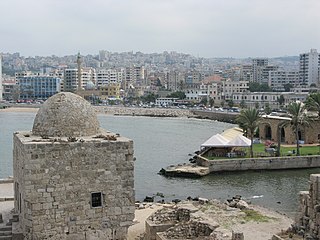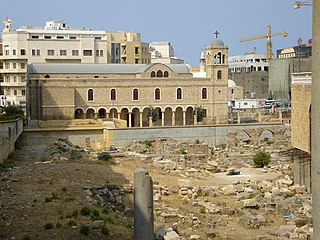
Sidon or Saida is the third-largest city in Lebanon. It is located in the South Governorate, of which it is the capital, on the Mediterranean coast. Tyre to the south and Lebanese capital Beirut to the north are both about 40 kilometres away. Sidon has a population of about 80,000 within city limits, while its metropolitan area has more than a quarter-million inhabitants.

Canaan was a Semitic-speaking civilization and region of the Southern Levant in the Ancient Near East during the late 2nd millennium BC. Canaan had significant geopolitical importance in the Late Bronze Age Amarna Period as the area where the spheres of interest of the Egyptian, Hittite, Mitanni, and Assyrian Empires converged or overlapped. Much of present-day knowledge about Canaan stems from archaeological excavation in this area at sites such as Tel Hazor, Tel Megiddo, En Esur, and Gezer.

Byblos, also known as Jebeil, Jbeil or Jubayl, is an ancient city in the Keserwan-Jbeil Governorate of Lebanon. The area is believed to have been first settled between 8800 and 7000 BC and continuously inhabited since 5000 BC. During its history, Byblos was part of numerous cultures including Egyptian, Phoenician, Assyrian, Persian, Hellenistic, Roman, Genoese, Mamluk and Ottoman. Urbanisation is thought to have begun during the third millennium BC and it developed into a city making it one of the oldest cities in the world. It is a UNESCO World Heritage Site.
The King of Tyre was the ruler of Tyre, the ancient Phoenician city in what is now Lebanon. The traditional list of 12 kings, with reigns dated to 990–785 BC, is derived from the lost history of Menander of Ephesus as quoted by Josephus in Against Apion I. 116–127. Josephus asserts that Menander had drawn his list from the chronicles of Tyre itself. Menander-Josephus also contains a list of 9 kings and judges, with reigns dated to 591–532 BC in Against Apion I. 154–160.

Berytus, briefly known as Laodicea in Phoenicia or Laodicea in Canaan from the 2nd century to 64 BCE, was the ancient city of Beirut from the Roman Republic through the Roman Empire and Early Byzantine period/late antiquity. Berytus became a Roman colonia that would be the center of Roman presence in the Eastern Mediterranean shores south of Anatolia.

The National Museum of Beirut is the principal museum of archaeology in Lebanon. The collection begun after World War I, and the museum was officially opened in 1942. The museum has collections totaling about 100,000 objects, most of which are antiquities and medieval finds from excavations undertaken by the Directorate General of Antiquities.

During the Middle Assyrian Empire and the Neo-Assyrian Empire, Phoenicia, what is today known as Lebanon and coastal Syria, came under Assyrian rule on several occasions.

Phoenicia under Roman rule describes the Phoenician city states ruled by Rome from 64 BCE to the Muslim conquests of the 7th century. The area around Berytus was the only Latin speaking and Romanized part of Aramaic-speaking Phoenicia.
The Assyrian conquest of Aram concerns the series of conquests of largely Aramean, Phoenician, Sutean and Neo-Hittite states in the Levant by the Neo-Assyrian Empire. This region was known as Eber-Nari and Aram during the Middle Assyrian Empire and the Neo-Assyrian Empire.

The architecture of Lebanon embodies the historical, cultural and religious influences that have shaped Lebanon's built environment. It has been influenced by the Phoenicians, Romans, Byzantines, Umayyads, Crusaders, Mamluks, Ottomans and French. Additionally, Lebanon is home to many examples of modern and contemporary architecture. Architecturally notable structures in Lebanon include ancient thermae and temples, castles, churches, mosques, hotels, museums, government buildings, souks, residences and towers.

Phoenicia, or Phœnicia, was an ancient Semitic thalassocratic civilization originating in the coastal strip of the Levant region of the eastern Mediterranean, primarily located in modern Lebanon. The territory of the Phoenicians expanded and contracted throughout history, with the core of their culture stretching from Arwad in modern Syria to Mount Carmel in modern Israel covering the entire coast of modern Lebanon. Beyond their homeland, the Phoenicians extended through trade and colonization throughout the Mediterranean, from Cyprus to the Iberian Peninsula.

The Temples of the Beqaa Valley are a number of shrines and Roman temples that are dispersed around the Beqaa Valley in Lebanon. The most important and famous are those in Roman Heliopolis. A few temples are built on former buildings of the Phoenician & Hellenistic era, but all are considered to be of Roman construction and were started to be abandoned after the fourth century with the fall of the Roman Paganism.
The Apostolic Vicariate of Beirut is a Latin Church ecclesiastical jurisdiction or apostolic vicariate of the Catholic Church in Lebanon, where Eastern Catholics are far more numerous. In 2010, there were 15,000 baptized. Its current bishop is Cesar Essayan.

Ancient Semitic-speaking peoples or Proto-Semitic people were speakers of Semitic languages who lived throughout the ancient Near East and North Africa, including the Levant, Mesopotamia, the Arabian Peninsula and Carthage from the 3rd millennium BC until the end of antiquity, with some, such as Arabs, Arameans, Assyrians, Jews, Mandaeans, and Samaritans having a continuum into the present day.
Phoenicia was an ancient Semitic-speaking thalassocratic civilization that originated in the Levant region of the eastern Mediterranean, primarily modern Lebanon. At its height between 1100 and 200 BC, Phoenician civilization spread across the Mediterranean, from Cyprus to the Iberian Peninsula.
Eshmunazar I was a priest of Astarte and the Phoenician King of Sidon. He was the founder of his namesake dynasty, and a vassal king of the Achaemenid Empire. Eshmunazar participated in the Neo-Babylonian campaigns against Egypt under the command of either Nebuchadnezzar II or Nabonidus. The Sidonian king is mentioned in the funerary inscriptions engraved on the royal sarcophagi of his son Tabnit I and his grandson Eshmunazar II. The monarch's name is also attested in the dedicatory temple inscriptions of his other grandson, King Bodashtart.

This article lists historical events that occurred between 101–200 in modern-day Lebanon or regarding its people.

This article lists historical events that occurred between 1–100 in modern-day Lebanon or regarding its people.

Sidon is one of the oldest inhabited cities in the world and has a rich and diverse history that spans over 6,000 years. The city's name has changed over time and has been known by various names, including Sidun, Saida, and Saïd. The earliest evidence of human settlement in the area dates back to the Neolithic period, around 4000 BCE. Sidon rose to prominence during the Bronze Age and became one of the most important city-states in the region. It was a major center for trade and commerce and played a significant role in the Mediterranean trade network. The city's strategic coastal location made it a hub for maritime activities.


















